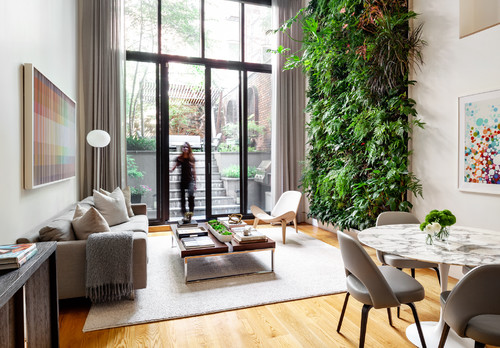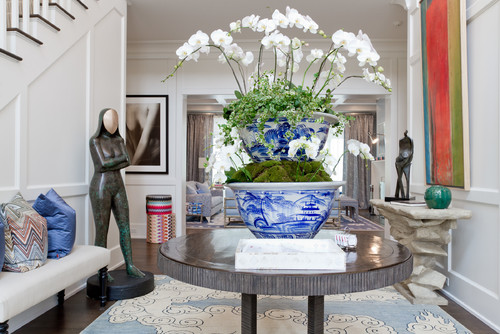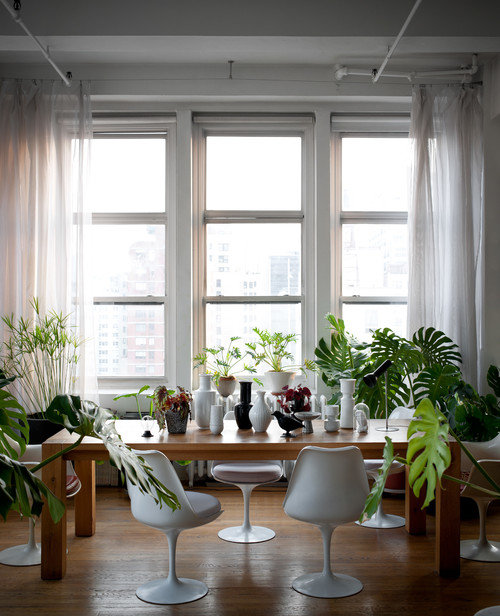
Moyo Studio / Getty Images
There are hairstylists, fashion stylists, even food stylists, so why not plant stylists?
These professional green thumbs may be rare, but their services are in increasing demand, particularly since Americans are snapping up greenery like crazy these days. But many aren’t sure what to do with the plants they have, or how to keep them alive and thriving. A plant stylist can help on all fronts.
What is a plant stylist?
Photo by Savvy Giving by Design
A plant stylist is, in a nutshell, a greenery pro who selects and tends pots to beautify the home. Stylists start by assessing several factors, including light, temperature, and draft to find plants that work best in each client’s environment, adds Anthony Watts, a plant stylist and owner of Layer.
Photo by Regan Wood Photography
If you’re tired of dusty leaves or your green plants are suddenly yellow, a plant stylist might be the solution.
“This professional can troubleshoot issues like these and also give tips for making plants work with your decor,” says Susan Brandt, a gardening pro at Blooming Secrets.
In fact, adding a green wall “has been shown to improve property values,” says Isara Ongwiseth, a plant specialist and lead designer at FormLA Landscaping.
Be aware that plant stylists aren’t cheap: Rates for a plant stylist start at $125 an hour and cover the design scheme, the actual plants, potting services, and delivery.
So if hiring a plant stylist to come to your home might not be in the cards right now, we thought we’d ask them to share their top tips so you can reap the benefits of their advice on your own. Check out what you should—and shouldn’t—do with your household plants.
Don’t fall for plant fads
Skip trendy plants you see all over the web—like, for example, the finicky fiddle-leaf fig, which tends to drop leaves and is highly susceptible to drafty rooms. Instead, Watts suggests picking ones that require minimum maintenance and provide the biggest visual payoff.
“My favorites are orchids and mature succulents since they need very little water and do well in low light, but I’ll also use tropical trees in varying sizes as they’re perennially verdant and make you feel like summer is always with you,” he says.
Do pick your containers carefully
Photo by Revolution Design House
One of the best parts of tending your own plants at home is choosing the vessels they’ll grow in, along with racks to line them up or contraptions for hanging greenery from the ceiling and on walls.
“Changing up the planters and containers you use is also a way to get trendy with your plants,” says Brandt.
“And once you catch the plant bug, you’ll want every stand, pot, watering can, and terrarium you see,” adds Ongwiseth.
Yet before you pull the trigger on that neon orange cachepot, make sure it has a hole in the bottom for proper drainage, as too much water in the soil can rot plant roots.
Don’t wing it with watering
While we’re on the topic of watering: Make sure you know how much and how often you’ll need to feed your new friends. Many plants require a weekly sprinkle, though others need much less. Ferns, for example, should get a thorough soaking when the top few inches of soil feel dry, which might mean weekly or every other day.
Spider plants need weekly water during the first year and then less after that, says Brandt. But orchids take just 1 to 3 ice cubes a week, depending on the size, and succulents should get a drink only when the top inch or so of dirt is dried out.
“Overwatering these two is the biggest issue for homeowners,” says Watts.
Do repurpose home gear
Photo by Living Gardens Landscape Design
There’s no need to spend a fortune on fancy clippers, say the pros, so grab what you have around the house for plant care.
“Repurpose a large French press for watering and use kitchen scissors to prune,” says Ongwiseth.
Don’t ruin floors and furniture
Plants can leak, especially if you’re overzealous when watering. You can add a plastic liner inside each plant container to catch excess water.
Watts also recommends sticking felt pads onto every pot to prevent scratches on furniture and floors.
The post Plant Stylists (Yes, That’s a Thing) Reveal Their Top Secrets for Going Green appeared first on Real Estate News & Insights | realtor.com®.







No comments:
Post a Comment